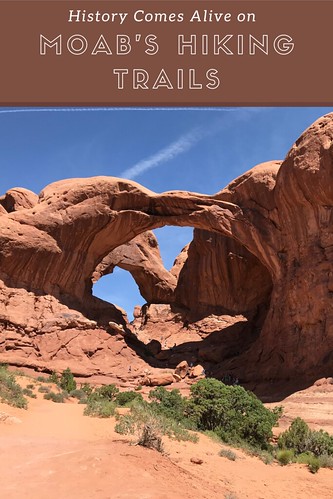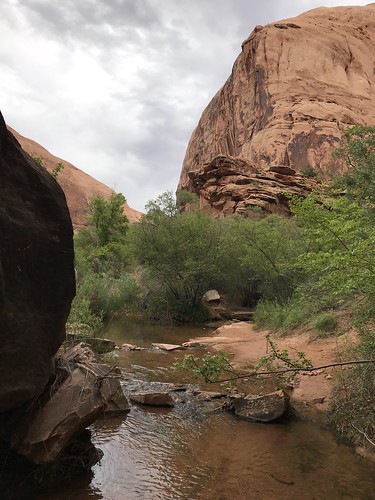History Comes Alive on Moab’s Hiking Trails
Museums and historical sites are not the only places where you can appreciate history. During a recent road trip to Moab, Utah, history came alive while exploring Arches National Park and trekking in the Grandstaff Canyon. These trails took me on a magical journey where I could view how the geological processes of deposition, uplift, deformation, and erosion created a colorful array of slickrock canyons, arches, domes, cliffs, spires, buttes, and mesas.

Visitors looking at this desert landscape will find it hard to imagine a time when water was the critical element in the region. Millions of years ago, seas ebbed and flowed, laying the salt sediments that would eventually become the landforms that we see today. Subsequent geological and weather events occurring over 100 million years created the spectacular formations—arches, spires, balanced rocks, sandstone fins, and eroded monoliths. Park officials and scientists regularly monitor the continual movement of the rocks’ cracks by collecting data with a crackmeter. The last collapse of a viewable arch occurred in 2008. Before settlers discovered the area, ancestral Puebloan, Fremont, and Ute people resided in the region and left behind a small number of pictographs and petroglyphs.

Flowering Cactus
Arches National Monument was established in 1929, and the designation was later changed to a national park in 1971. Today, visitors can see the highest concentration of natural stone openings in the world. The term arch is given to arches with a minimum opening of three feet. Even though park rangers have identified almost 2,000 arches, visitors have access only to about 100.
ARCHES NATIONAL PARK
During my most recent visit to this exceptional national park, I was able to see how this captivating landscape engaged our two preschool grandchildren. During our slow pace, the children were able to appreciate Mother Nature’s handiwork—the creation of magnificent landforms.
Park Avenue Trail
“Wow!” was the first response we heard from our three-year-old grandson when we started walking into this spectacular canyon. As the sun was casting shadows on the massive fins, balanced rocks, and lofty monoliths, it was hard not to be overwhelmed by the surrounding natural beauty.

Hiking on Park Avenue Trail
For more than 150 million years, the forces of nature have been working to create multi-colored layers of Entrada Sandstone. Nowadays, the 8-10 inches of annual precipitation slowly dissolves portions of the rounded grains of compacted porous sand, and the temperature changes in the winter months cause these rocks to freeze and contract.
Adults likewise stand in awe as they admire the vertical slabs, often called fins, reaching toward the blue sky like towering skyscrapers. Yes, this visual representation is the source for the name, Park Avenue Trail.
While our grandson and his younger toddler sister were attempting to walk off the path, we gently reminded them that the surrounding ground was fragile and could not be stepped upon. Even though they are too young to appreciate the importance of not disturbing the biological soil crust—a mixture of cyanobacteria, mosses, lichens, fungi, and algae—we understood how these plants work in harmony to keep the desert sand healthy and prevent erosion.

Park Avenue Trail Landscape
Double Arch and Windows Trails
Both of these trails are accessed at the cutoff after the Balanced Rock landmark. At the end of the Double Arch Trail, the third-largest arch with a span of 144 feet and a height of 112 feet, can be viewed.
A slightly longer trail leads to Turret Arch, South Window, and North Window. An informative sign identifies the geological steps leading to arch formation. Over the course of millions of years of being exposed to the elements, the entrada sandstone developed a series of cracking. As the erosion process intensified, the cracks became increasingly more pronounced and broader. When a sufficient amount of rock fell off, an opening developed. The erosion process caused space to eventually develop into an arch. Over time, the arches will destroy themselves and crumble to the ground.

Windows Arch
Even though our grandchildren are too young to understand the processes that led to the formation of these landforms, they definitely enjoyed the opportunity to scamper and climb in the boulders as well as stand in awe as they gazed at geological wonders.

Hiking on Window Trail
Landscape Arch Trail
Landscape Arch is the longest natural stone span in the world. Scientists continue to speculate whether the large pieces that have fallen off indicate that the arch is nearing the end of its existence or whether its sleeker shape will provide more durability. I do recall the ability to go closer to the arch decades ago. Today safety prevails, and the arch can only be viewed from behind a wooden fence. It remains a fantastic site to see for young and old.

The wide, partially paved path is handicap and stroller friendly until approaching the arch. People seeking more adventure can trek further on the more difficult Double O Arch trail.

Hiking on Landscape Arch Trail
MOAB TRAILS
Grandstaff Canyon Trail
At the trailhead, hikers can read a short biography of William Grandstaff’s life, one of Moab’s first settlers. According to the National Multicultural Western Heritage Museum website, Grandstaff traveled to “the West as a refugee from post-Civil War South in search of a better life.” Grandstaff, a half black and half Native American cowboy, lived in Moab as a homesteader, farmer, rancher, and prospector from 1877 to1881. This canyon was his home until he was forced to abandon his cabin after being accused of selling alcohol to Native Americans during an uprising. He resettled in Glenwood Springs, Colorado, where he became an active member of the community and a miner. In earlier times, the canyon was called “Negro Bill Canyon.” The trailhead was officially renamed in 2016.

Sandy at Grandstaff Canyon Trail

Stream running through Grandstaff Canyon
This trail is an excellent choice for visitors seeking a path partly protected by canyon walls and mature vegetation. The trail weaves back and forth across a stream, so the ability to cross by stepping on slippery rocks is a necessity. Hikers should also note that poison ivy plants and cacti are ubiquitous. The highlight of the journey is the Morning Glory Natural Bridge, a landform spanning over a waterway. Disappointingly, the trail was too long for our grandson’s short legs, so we were unable to see the natural bridge.

Hiking along creek bed in Grandstaff Canyon
PANDEMIC ROAD TRIP
During the pandemic, many people are opting to take road trips. Traveling to Utah is just one of many options for safe outdoor adventures. This state is known for its abundance of state and federal parks.
Our latest visit occurred in early June. Before embarking on this short road trip, I talked extensively to Daniel Loveridge, the general manager at the Hoodoo Moab, a Curio Collection by Hilton hotel. This full-service, four-star hotel with a restaurant and a swimming pool opened in August 2019 and was forced to temporarily close when the local government shut down tourism in March. The hotel partially reopened the beginning of May. Loveridge explained the safety measures being implemented, as well as the available food options. While I have to admit that I was a bit apprehensive to take a pandemic road trip, I enjoyed every minute and felt safe during our short stay.

Hoodoo Moab Pool Area
As a grandparent, it is fascinating to watch grandchildren learn about the world. While hiking on Moab’s trails, history comes alive when geology collides with natural beauty.
Sandy Bornstein, the History Comes Alive Through Travel Editor for Wandering Educators, has visited more than 40 countries and lived as an international teacher in Bangalore, India. Sandy’s award-winning book, May This Be the Best Year of Your Life, is a resource for people contemplating an expat lifestyle and living outside their comfort zone. Sandy writes about Jewish culture and history, historical sites, family, intergenerational, and active midlife adventures highlighting land and water experiences.
All photos courtesy and copyright Sandy Bornstein
Disclosure: The Traveling Bornsteins received a media rate for their two suites at the Hoodoo Moab, a Curio Collection by Hilton.


















